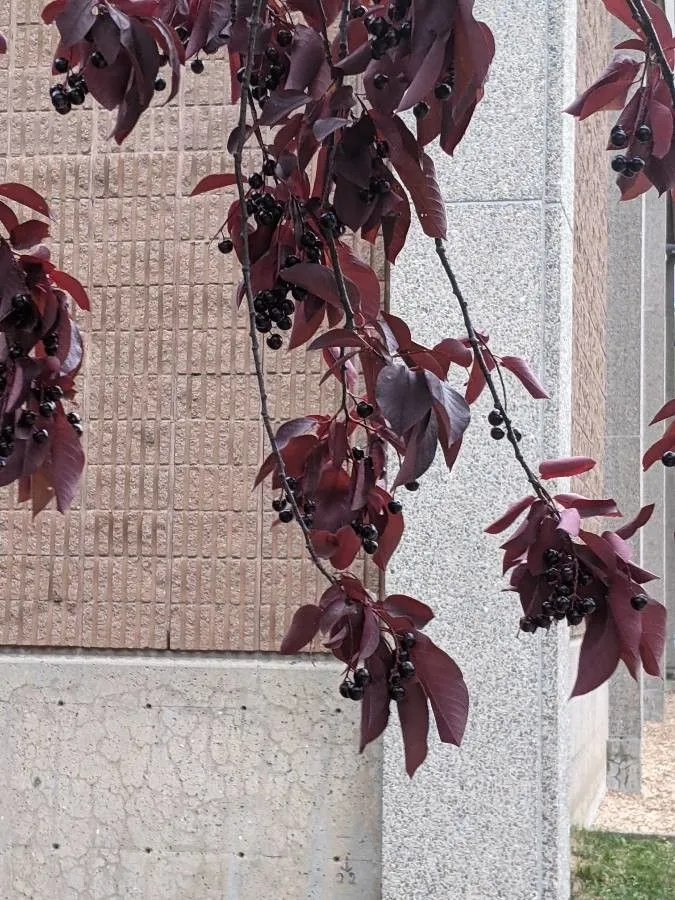
Author: L.
Bibliography: Sp. Pl.: 473 (1753)
Year: 1753
Status: accepted
Rank: species
Genus: Prunus
Vegetable: Unknown
Observations: Subarctic America to N., C. & E. U.S.A.
Bitter-berry, scientifically known as Prunus virginiana, is a notable member of the Rosaceae family. First documented in the seminal botanical work “Species Plantarum” by Carl Linnaeus in 1753, this plant has since established its presence across a broad range of North America.
This hardy species flourishes in diverse environments, spanning from the subarctic regions of Canada to the northern, central, and eastern United States. The adaptability of Bitter-berry to various climates and soils underscores its robustness and ecological versatility.
Typically found in woodlands, along streams, and at the edges of forests, Prunus virginiana is a deciduous shrub or small tree. It is well-regarded for its oval, serrated leaves that turn vibrant hues in the autumn, adding to the seasonal palette of its native habitats. In the spring, it produces clusters of small, white flowers, which later give way to its namesake—bitter, red to black drupes. These berries, while astringent to the human palate, are an important food source for wildlife, including birds and mammals.
Beyond its ecological contributions, Bitter-berry has cultural and historical significance. Indigenous peoples and early settlers utilized parts of the plant for both medicinal and culinary purposes, often crafting the inner bark into teas to treat ailments. The wood, known for its fine grain and durability, was also employed in various tools and crafts.
In contemporary horticulture, Prunus virginiana is valued for its ornamental properties and resilience, making it a popular choice for naturalized gardens and landscape restoration projects. Its ability to thrive in a range of conditions and its picturesque seasonal changes ensure that it maintains an enduring presence in the botany and gardening worlds.
Whether appreciated for its environmental benefits, historical uses, or aesthetic qualities, the Bitter-berry stands as a compelling example of a plant species that seamlessly blends beauty and functionality.
Eng: bitter-berry, chokecherry, common chokecherry, virginia bird cherry, virginia chokecherry, eastern chokecherry, red chokecherry
Fra: cerisier de virginie, cerises-à-grappe, cerisier à grappes
Deu: virginische trauben-kirsche, virginische traubenkirsche, virginischer traubenkirschbaum
Dan: virginsk hæg
Spa: cerezo de virginia
Ces: střemcha viržinská
Nob: virginiahegg
Nno: virginiahegg
Swe: virginiahägg, virginiantuomi
Fin: virginiantuomi
Nld: kleine vogelkers, virginische vogelkers
En: Bitter-berry, Chokecherry, Virginia bird cherry, Western choke cherry, Choke Cherry, COMMON CHOKECHERRY, Chokecherry (common), Menôtse, Virginia chokecherry, Eastern chokecherry, Red chokecherry, Common Choke-cherry
Be: Чаромха віргінская
Ca: Cirerer de Virgínia
Zh: 北美稠李
Hr: Virginijska borovnica
Cs: Střemcha viržinská
Da: Virginsk hæg
Nl: Kleine vogelkers, Virginische vogelkers
Fi: Virginiantuomi
Fr: Cerisier de Virginie, Cerises-à-grappe, Cerisier à grappes
De: Virginischer Traubenkirschbaum, Virginische Traubenkirsche, Virginische Trauben-Kirsche
Is: Virginíuheggur
It: Ciliegio della Virginia
Kv: Виргинияись льӧм
Lt: Virgininė ieva
Nv: Kʼįįshzhíní
No: Virginiahegg
Nb: Virginiahegg
Nn: Virginiahegg
Fa: گیلاس گلوگیر
Pl: Czeremcha wirginijska
Qu: Kapuli
Ru: Черёмуха виргинская
Es: Cerezo de Virginia
Sv: Virginiahägg, Virginiantuomi
Taken Aug 5, 2021 by Makayla Osipenko (cc-by-sa)
Taken Aug 7, 2021 by Alia Kolodychuk (cc-by-sa)
Taken Jul 31, 2021 by Nicole Morrow (cc-by-sa)
Taken Aug 13, 2021 by Ray Boyd (cc-by-sa)
Taken May 26, 2020 by L Reginelli (cc-by-sa)
Taken Aug 29, 2020 by Fraser Hutchison (cc-by-sa)
Taken May 24, 2021 by Kathryn Stocks (cc-by-sa)
Taken May 17, 2021 by philip beef (cc-by-sa)
Taken May 29, 2022 by WT1000K (cc-by-sa)
Taken Apr 1, 2020 by Matthias Foellmer (cc-by-sa)
Taken Aug 26, 2020 by shirley berry (cc-by-sa)
Taken Jul 31, 2021 by Nicole Morrow (cc-by-sa)
Taken Jul 22, 2021 by Samantha Krueger (cc-by-sa)
Taken Jul 20, 2021 by Sandrine Zuyderhoff (cc-by-sa)
Taken Jan 28, 2022 by Eileen T (cc-by-sa)
Taken Jun 6, 2022 by Andrea Cordon (cc-by-sa)
Taken Jul 20, 2020 by julien blundell (cc-by-sa)
Taken Aug 31, 2022 by Michael Harward (cc-by-sa)
Taken Apr 1, 2020 by Matthias Foellmer (cc-by-sa)
Taken Aug 7, 2021 by Alia Kolodychuk (cc-by-sa)
Taken May 16, 2022 by Bryce Avot (cc-by-sa)
Taken Jul 21, 2020 by Joanna Lumbsden (cc-by-sa)
Taken Jul 25, 2021 by Nyunyshkin (cc-by-sa)
Taken Aug 11, 2021 by France Loiselle (cc-by-sa)
Taken Apr 1, 2020 by Matthias Foellmer (cc-by-sa)
Taken Jul 28, 2021 by Ник Елена (cc-by-sa)
Taken Jun 21, 2020 by Thorsten Simon (cc-by-sa)
Taken Aug 18, 2020 by Katelynn Schultz (cc-by-sa)
Taken May 4, 2022 by Hoppe Ewald (cc-by-sa)
© copyright of the Board of Trustees of the Royal Botanic Gardens, Kew.
© copyright of the Board of Trustees of the Royal Botanic Gardens, Kew.
© copyright of the Board of Trustees of the Royal Botanic Gardens, Kew.
Family: Myrtaceae Author: (F.Muell.) K.D.Hill & L.A.S.Johnson Bibliography: Telopea 6: 402 (1995) Year: 1995 Status:…
Family: Rubiaceae Author: Pierre ex A.Froehner Bibliography: Notizbl. Bot. Gart. Berlin-Dahlem 1: 237 (1897) Year:…
Family: Sapindaceae Author: Koidz. Bibliography: J. Coll. Sci. Imp. Univ. Tokyo 32(1): 38 (1911) Year:…
Family: Asteraceae Author: A.Gray Bibliography: Pacif. Railr. Rep.: 107 (1857) Year: 1857 Status: accepted Rank:…
Family: Fabaceae Author: Medik. Bibliography: Vorles. Churpfälz. Phys.-Ökon. Ges. 2: 398 (1787) Year: 1787 Status:…
Family: Aspleniaceae Author: (Cav.) Alston Bibliography: Bull. Misc. Inform. Kew 1932: 309 (1932) Year: 1932…